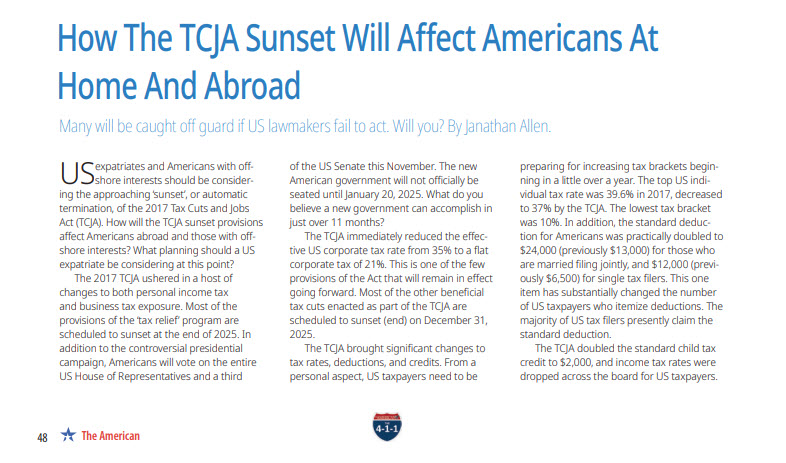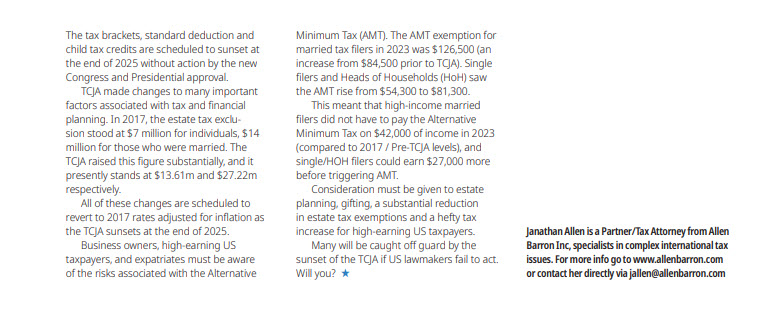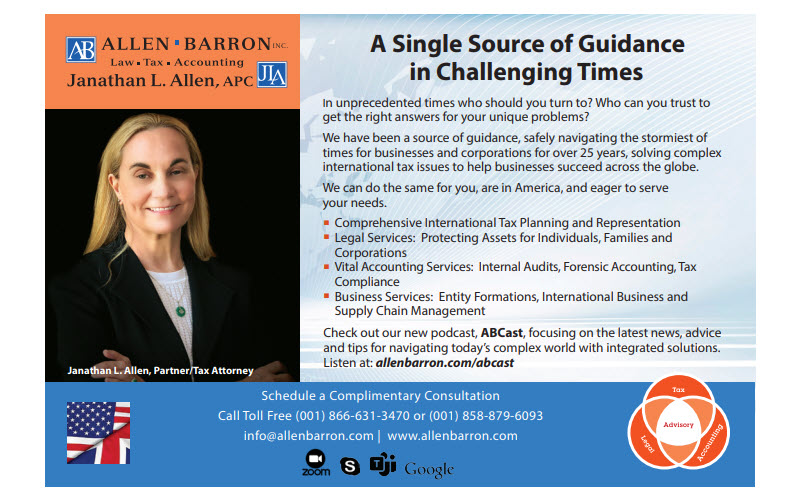




U.S. expatriates and Americans with offshore interests should be considering the approaching sunset of the 2017 Tax Cuts and Jobs Act or TCJA. How will the TCJA sunset provisions affect Americans abroad and those with offshore interests? What planning should a U.S. expatriate be considering at this point?
The 2017 TCJA ushered in a host of changes to both personal income tax and business tax exposure. Most of the provisions of the “tax relief” program are scheduled to sunset at the end of 2025. In addition to the controversial presidential campaign, Americans will vote on the entire U.S. House of Representatives and a third of the U.S. Senate this November. The new American government will not officially be seated until January 20, 2025. What do you believe a new government can accomplish in just over 11 months?
The TCJA immediately reduced the effective U.S. corporate tax rate from 35% to a flat corporate tax of 21%. This is one of the few provisions of the Act that will remain in effect going forward . Most of the other beneficial tax cuts enacted as part of the TCJA are scheduled to sunset (end) on December 31, 2025.
The TCJA brought significant changes to tax rates, deductions, and credits. rom a personal aspect, US taxpayers need to be preparing for increasing tax brackets beginning in a little over a year. The top US individual tax rate was 39.6% in 2017, decreased to 37% by the TCJA. The lowest tax bracket was 10%. In addition, the standard deduction for Americans was practically doubled to $24,000 (previously $13,000) for those who are married filing jointly, and $12,000 (previously $6,500) for single tax filers. This one item has substantially changed the number of US taxpayers who itemize deductions. The majority of US tax filers presently claim the standard deduction.
The TCJA doubled the standard child tax credit to $2,000, and income tax rates were dropped across the board for US taxpayers. The tax brackets, standard deduction and child tax credits are scheduled to sunset at the end of 2025 without action by the new Congress and Presidential approval.
TCJA made changes to many important factors associated with tax and financial planning. In 2017, the estate tax exclusion stood at $7 million for individuals, $14 million for those who were married. The TCJA raised this figure substantially, and it presently stands at $13.61 million (individual) and $27.22 million (married).
All of these changes are scheduled to revert to 2017 rates adjusted for inflation as the TCJA sunsets at the end of 2025.
Business owners, high-earning U.S. Taxpayers, and expatriates must be aware of the risks associated with the Alternative Minimum Tax (AMT). The AMT exemption for married tax filers in 2023 was $126,500 (an increase from $84,500 prior to TCJA). Single filers and Heads of Households (HoH) saw the AMT rise from $54,300 to $81,300.
This meant that high-income married filers did not have to pay the Alternative Minimum Tax on $42,000 of income in 2023 (compared to 2017 / Pre-TCJA levels), and single/HOH filers could earn $27,000 more before triggering AMT.
Consideration must be given to estate planning, gifting, a substantial reduction in estate tax exemptions and a hefty tax increase for high-earning US taxpayers. Many will be caught off guard by the sunset of the TCJA if US lawmakers fail to act. Will you?
